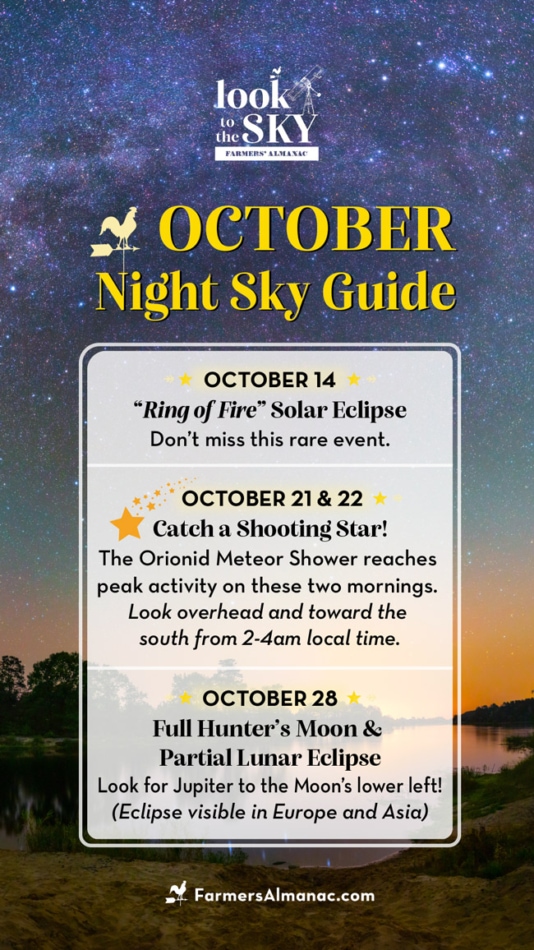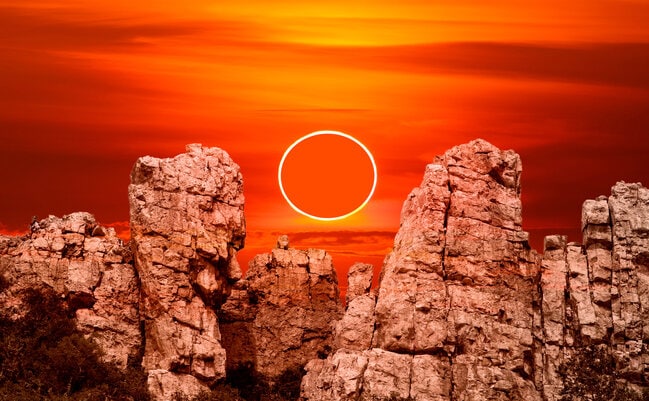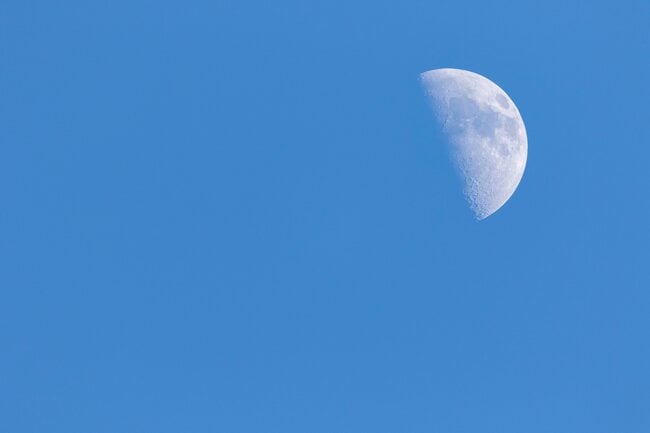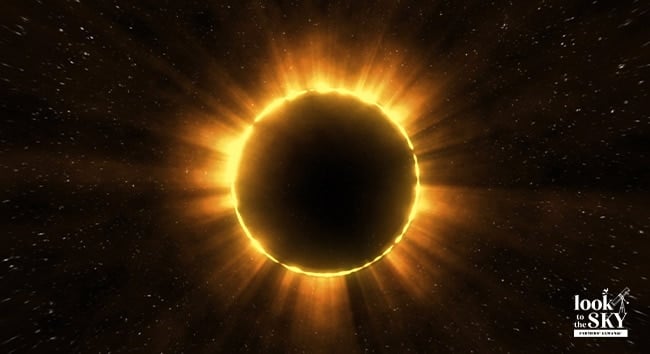The October sky will have many celestial highlights including: a rare “Ring Of Fire” solar eclipse, shooting stars during the Orionid Meteor Shower, and the Full Hunter’s Moon close to Halloween (spooky)! There are also ample opportunities for stargazing, especially around the new Moon! All the details you need are here in our monthly calendar of night sky stars and events! Have any questions? Leave your thoughts in the comments section below!
Note: All times and positions are listed in Eastern time, 40 degrees north of the equator—unless otherwise listed. If you see the term “local time,” it is true no matter where you are located (no need to add or subtract for your time zone).
Look for the telescope emoji – 🔭 – as a quick reference for when recommend using telescopes and binoculars.
Bookmark this page now (Press command+D on your keyboard) so you can easily refer to it for stargazing over the next few weeks.

October Night Sky Guide
🔭 October 1 – Mercury And Jupiter
Get a glimpse of Mercury in the morning twilight the first few days of this month. On October 1, this planet of magnitude -1.0 rises approximately one and one quarter hour before the Sun and can be found with binoculars 30 degrees to the lower left of Venus. Mercury had a fine morning apparition in mid-to-late September, but now this smallest and fastest of planets appears lower in the dawn each day. Look for it now because it will disappear into the glare of the Sun after the first week of October.
In the early evening, look west for Jupiter rising about 90 minutes after sunset. It rises earlier each evening as the month advances. Tonight, look low toward the east-northeast horizon around 9 p.m. local daylight time and you’ll find Jupiter shining brilliantly about 2 degrees to the lower right of a waning gibbous Moon.
October 6 – Last Quarter Moon
The last quarter Moon occurs at 9:48 a.m. EDT.
Related: Moon Phases Explained
October 10 – The Crescent Moon And Venus
Look southeast one hour before sunrise (for mid-Northern latitudes) to catch a lovely waning crescent Moon and Venus hanging close by. You may also locate the brightest star in Leo, Regulus, to the lower right. Note: Venus reaches its highest point in the pre-dawn sky in October, about 30 degrees above the horizon.
⭐ October 14 – New Moon And “Ring Of Fire” Solar Eclipse
The new Moon occurs at 1:55 p.m. EDT. Also today, the Sun undergoes a solar eclipse that will be widely visible throughout most of the Western Hemisphere. This will be an annular or “ring of fire”eclipse.
On this occasion, the Moon will be too far away from Earth to completely cover the Sun, so as a result when they appear exactly aligned, a ring of sunlight will appear to shine around the Moon’s silhouette. The effect will be similar to placing a penny on a nickel, with the penny representing the Moon and the nickel representing the Sun.

The path of the ring phase forms a 152-mile-wide corridor and will traverse portions of nine states: Oregon, California, Idaho, Nevada, Utah, Colorado, Arizona, New Mexico, and Texas. Depending on where you are stationed within the path, the annular phase may last a little more than five minutes. If you are outside of the annular eclipse zone, you may still see a partial eclipse, but the closer you are to the path of annularity, the greater the amount of the Sun will be hidden by the Moon.
Related: 10 Strange Facts About The “Ring Of Fire” Solar Eclipse
Note: If you intend to view this event, do not look directly at the Sun without protecting your eyes. Either utilize special Solar Eclipse Glasses (available in a four-pack from the Farmers’ Almanac) or project the Sun’s image through a pinhole onto a screen. Learn how.
Psst … Almanac astronomer, Joe Rao, who also serves as an associate and guest lecturer at New York’s Hayden Planetarium, is offering virtual presentations (via Zoom) about solar eclipses, as well as April’s Great North American Total Eclipse for libraries and civic groups. If you’re interested, write to him.
October 16 – New Moon “Star View”
The days before and after a new Moon are ideal for stargazing. Each month, we suggest a few bright night sky stars to catch around this time.
Look to the southern skies at around 8 p.m. You will find some interesting constellations in this part of the sky, though their figures are all rather dim. This whole area can be called the “Watery” part of the sky. It isn’t really watery, of course. It is watery in the sense that it is vague and dim, like a dark pool. Due south at chart time is the star pattern that contains the brightest star of this dim fraternity: Piscis Austrinus, the Southern Fish (not to be confused with Pisces).
The faint night sky stars which make up most of this constellation usually cannot be seen as they are usually too low in the sky. However the constellation’s main star, Fomalhaut, is ranked the eighteenth brightest star in the sky. Sometimes called “The Solitary One,” Fomalhaut lies in an empty region of the autumn skies, the southernmost of the visible first-magnitude stars for New Yorkers. Fomalhaut is Arabic for “mouth of the fish.” It lies at a distance of 25 light years, a star nearly twice the diameter of the Sun and is 16 times more luminous.
October 20 – Mercury Conjunction
Mercury reaches superior conjunction with the Sun. It will have a low apparition in the evening sky in late November and early December.
October 21 – First Quarter Moon
The first quarter Moon occurs at 11:29 p.m. EDT.

⭐ October 21+22 – Catch A Shooting Star In The October Night Sky!
Love stargazing? One of the best annual meteor displays, the Orionids, will reach peak activity between October 20-25, but we recommend the early morning hours of October 21 and 22. Look overhead and towards the south between 2-4 a.m. local time.
Producing about 25 swift meteors per hour, the Orion Meteor Shower appears to dart from a region of the sky just north of the ruddy star Betelgeuse in Orion. The Orionids—like the spring Eta Aquarids—are presumed to be particles shed by Halley’s comet centuries ago. The first-quarter Moon sets around 11:30 p.m. on the 21st, leaving a dark sky thereafter. It sets a little more than an hour later each subsequent night.
🔭 October 23 – Venus And Saturn
Lamp-like Venus attains greatest elongation (46 degrees west of the Sun) this morning, rising several minutes short of 4 hours before our star. The planet’s globe may not appear half-lit in a telescope until several days later. Check each morning. Venus’s apparent diameter shrinks by 30% during October, while its phase thickens from 37% to 55% illuminated.
Saturn is high in the southeast at nightfall and reaches its peak altitude in the south around midevening. It’s by far the brightest thing in Aquarius—a steady yellow light of magnitude +0.7. This evening, Saturn stands well to the upper left of the waxing gibbous Moon but otherwise seems an outcast. The only really naked-eye star within less than two degrees of it is Iota Aquarii, magnitude +4.3. In a telescope Saturn’s rings appear more tilted—nearly ten degrees—than they were during the spring and summer. Now is also a good time to see if you can detect a few of the Saturnian globe’s subtle dark belts and light zones. And Saturn never lacks close company: its orangey 8th-magnitude Moon Titan is bright enough to show at 25X in a small telescope.
⭐ October 28 – Full Hunter’s Moon And Lunar Eclipse
The full Hunter’s Moon occurs at 4:24 p.m. EDT.
There will also be a partial lunar eclipse, with the Earth’s dark umbral shadow skimming the Moon’s southern edge and covering at most only about 1/20 of the area of the Moon’s circle.
At mid-eclipse the umbra’s edge falls just shy of touching the brilliant-rayed crater, Tycho. The Earth’s Eastern Hemisphere faces the Moon when this eclipse takes place. However, the Earth’s rotation will bring the Canadian Maritime provinces into position to see the last of the umbra slip off the Moon as it rises. Sharp-eyed New Englanders will be able to see the faint shading of the penumbra as the Moon appears above their horizon, but the rest of North America will see nothing, as this event occurs before moonrise.
As a consolation prize for much of America, for a second time this month the Moon and Jupiter make for an eye-catching pair. Look for them appearing due east at around 8 p.m. local daylight time, with Jupiter hovering about 4 degrees to the Moon’s lower left. Jupiter is less than a week from opposition on November 3, when it rises at sunset and sets at sunrise. By the middle of the night the behemoth world shines more than 60 degrees high in the south for viewers at latitude 40 degrees north.
Join The Discussion!
Do you love stargazing?
Do you have any favorite night sky stars?
Which October night sky event are you looking forward to?
Share with your community here in the comments below!
Related
Monthly Stargazing Guides – Bookmark this page now!

